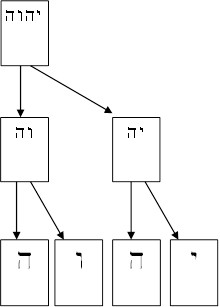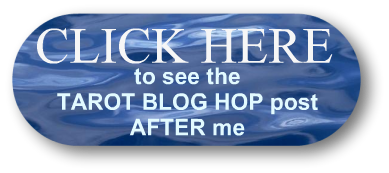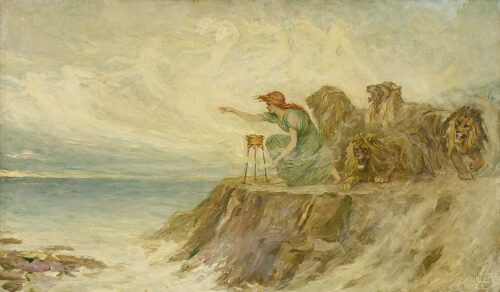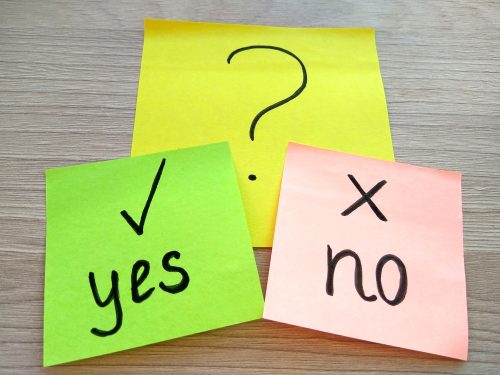Welcome to the Tarot Blog Hop!
An international group of tarotists are all writing on the same topic and then linking to each other so that the reader can hop from one blog to the next, seeing all the permutations and facets that the topic inspired in different writers. You can hop back to Inner Whispers: Musings on tarot, yoga, and life. Or read ahead here and then hop forward!
Pentacles: The Fruits of Harvest

Have you ever gotten stuck on a project? Or wanted a particular outcome that never seemed to come about? There is a very simple check list you can use to identify and correct any missteps in your manifestation process so you can create the goal you desire. This checklist is derived from the four worlds of qabalah. Qabalah is a philosophical and meditative practice based on Jewish mysticism.
One of the concepts that is introduced early on in the study of qabalah is that of the four worlds. The four worlds are the stepping stones from the realm of pure divinity to the world of concrete reality. By learning how these realms function in a practical manner, you can use them as a blueprint for bringing your creative sparks into physical manifestation.
The four worlds of qabalah correspond to the Tetragrammaton. The Tetragrammaton is the ineffable four-letter name of God. In English transliteration, it is generally spelled “YHVH” and pronounced using the Hebrew letters “yud, heh, vav, heh.” This is the word that is often translated as Jehovah or Yahweh in the Bible. This name is derived from the Hebrew verb “to be.”
The first world is Atziluth. It is the realm of Emanation and corresponds to the letter Yud, the element fire, and the tarot suit of Wands. The word emanate means to flow, come out from a source, to spring. Emanation also refers to the creation of the world through a series of steps, like climbing down the rungs of a ladder, from pure Godhead to the world of matter.
One way of looking at the world of Emanation is to think of it as inspiration. This is that split-second moment when you get a brilliant idea. Not something you have been carefully planning out in your mind, but that something-from-nothing divinely inspired concept. This is the goal you are trying to achieve.
The second world is that of Briah. Briah is the world of Creation and corresponds to the letter Heh, the element water, and the tarot suit of Cups. In the manifestation process, Briah represents dreaming about all the possibilities open to us. It is associated with creativity and artistry, so this is the stage where you can fantasize all kinds of crazy, beautiful, and fantastical variations on your initial idea.
The world of Briah is also where you emotionally engage with your process. Your excitement and anticipation and happiness around starting this project as well as your affection for and satisfaction around achieving the outcome are all important motivators.
The third world is Yetzirah. This is the world of Formation and is associated with the letter Vav, the element air, and the tarot suit of Swords. Formation is the stage in which we measure and cut. This might be literal such as marking and cutting your material, for example, wood or fabric. The detailed measurements provided in the book of Genesis as instructions for the ark are an example of the qualities of the world of Formation.
The world of Yetzirah also has to do with making choices and decisions. It’s putting words on the page, choosing the exact beads and determining the order you will string them in, setting deadlines. Yetzirah is also about cutting away. This is where you trim the fat, making decisions about eliminating the inessential. Yetzirah takes the expansive dreams of Briah and places the limitations on them that allow us to proceed with a particular choice toward the ultimate goal.
The final world is that of Assiah. Assiah is the world of Manifestation or Action. It is symbolized by the final Heh, the element earth, and the tarot suit of Pentacles. This is our final product, our completed task. The pentacles are indeed the fruits of the harvest! Often when our ideas take physical form, they are not exactly as we dreamed them. But the sense of accomplishment and fulfillment of completion is tangible even if our end product has flaws. This result of our four step process reflects how we worked through each of the worlds.
If your end result does not reflect your initial concept, you will find that you took a wrong turn in one of the previous worlds. Or if you are a dreamer or someone with unfinished projects scattered everywhere you will see that you have not fully engaged the force of taking action in the world of Assiah.
Four Worlds Tarot Spread
This is a very easy, focused and to-the-point spread that immediately highlights where you are in the manifestation process. It’s based on the first few steps of the first operation of the Golden Dawn’s Opening the Key spread.

- Pick a Significator. This is a card, often a court card, that represents you (or the person you are reading for). You can select the significator based on your physical appearance, personality, astrological sign, or any combination of these factors or other relevant factors. Or choose a favorite card or a special one that you get often in readings.
- Place the significator in the deck and shuffle the cards while concentrating attentively on the outcome you wish to manifest.
- Place the pack of cards face down on the table before you. The pack represents the Tetragrammaton, YHVH.
- As evenly as possible, cut the deck, placing the top half of the deck to the right. The right-hand pack represents YH and the left hand pack represents VH.
- As evenly as possible, cut the YH pack to the right, creating a Y and H pack. Do the same with the VH pack.
- You now have four packs of approximately equal size, representing the letters of the Tetragrammaton.
- Turn the four packs face upwards but don’t alter their position or order. The four bottom cards will provide an overview of your process.
- Y=The far right card represents inspiration—what does this card say about your connection to the Divine? Are you crystal clear on your goal or objective?
- H=The second card from the right represents your emotional connection to your desired outcome. Are you dreaming big enough? Or too big? Are you excited? Lackluster?
- V=The third card from the right represents how you engage your editorial and decision making process. What do you need to sacrifice to make this happen?
- H=The final card, the card to the far left, suggests the likely outcome if no changes are made to your manifestation process; this card might also give you direction into actions that you can take.
- Look through each pack to find the significator. Make a note of which pack, Y H V or H it came from.
- Y=Atziluth, the world of inspiration
- H=Briah, the world of dreams and emotional activation
- V=Yetzirah, the world of measuring, cutting, editing and decisions
- H=Assiah, the world of the finished project, of taking action
- Which world was your significator in? This might be a suggestion as to where you can focus to most effectively bring about your fully manifested goal.
Enjoy the fruits of your harvest!
Your Next Stop
Hop ahead to Beauty, History, Magic, or visit the master list of all the blogs.
Joy Vernon is a Certified Professional Tarot Reader and Reiki Teacher in Denver, Colorado. Her specialty is the Empyrean Key Transformational Guidance, which combines energetic and esoteric modalities to help her clients break through blocks and align themselves with their higher purpose. For information on upcoming classes or to schedule an appointment, please visit JoyVernon.com.
© 2012 by Joy Vernon. All rights reserved.











Thanks so much for sharing this spread! I will definitely use it when I read for myself next time! 🙂
You’re welcome John!
Omigosh, Joy, the whole Qabalah thing makes my head feel like it’s going to explode! This looks like a great spread to try, I am going to have a bash at it this weekend. x
It only explodes in a really good way! Trust me 🙂
Lovely post, Joy! I like your tetragramaton approach to the opening of the key spread – definitely useful to check where we are in our manifestation process 🙂
It’s a great spread for developing task lists! A very practical use. I’m glad you like it!
Thank you. I’ve only recently learned the Opening of the Key. I enjoyed this.
It’s a great spread and only difficult if you try to tackle the whole thing at once (as I did at first!). When you get used to it one small step at a time (like here, where we’re not even doing the whole first operation) it becomes pretty easy. If you’re just learning the Opening of the Key, you might find useful my handout from DTM: http://files.meetup.com/283307/2012%20Dignities%20presentation.pdf
Got to love the OOTK spread! Well laid-out and explained!
Ali x
Thanks Ali!
this is a great idea, and I bet very useful when creativity is stuck.
Thanks, Joy! I’ve seen the whole spread, and it is pretty overwhelming (gee, the Tree of Life is pretty complex in one world, let alone four!). This spread was a very good introduction to a piece of it for me as I wade through the Thoth Tarot and Duquette’s book.
Tried the spread out and it gave an interesting reading based on the Universal Tarot of Marseille and Lee Bursten’s interpretive model on a question about a deck project I’m working on.
Thanks again!
The Opening of the Key Tarot Divination Re-evaluated…
© Alex Sumner 2013 This post has come about due to a Facebook conversation about what Divination I tend to do before Magick. Actually I found this so inspiring that instead of just another FB reply I thought i would devote a whole blog post to the subj…
Nice post! I completely agree with you that each card combination can be read very quickly with word pairs or short phrases–the Regardie Golden Dawn big book includes examples done presumably by Mathers that demonstrate that he was going fairly quickly through the pairs. Remember that the GD was developing their techniques based on writers such as Eteilla, so there is a surprising amount of fortune-telling or cartomancy reading style going on here. In many ways this technique reads more like Lenormand than intuitive tarot. I can do the first op for a client in 20-40 minutes depending on the reading time frame and how in-depth the question is. When you really get going with it, the cards just start unfolding stories and each op seems to answer the next set of questions the client has. It really gets going pretty fast. When I first did it for myself, years ago, I remember how overwhelming it all was (I was still trying to learn just the counting at that point) and I spent three hours on it before giving up. But I was reading for myself and trying to journal it as I went which is very time-consuming. But when you’re in a client situation you’re talking the reading out, not writing it out, and the cards come together and speak quickly and directly. It’s amazing to watch them morph to address different aspects of what’s going on. Love this spread!
[…] out the Four Worlds Tarot Spread or the Revolutionary Wheel Tarot Spread, both based on the […]